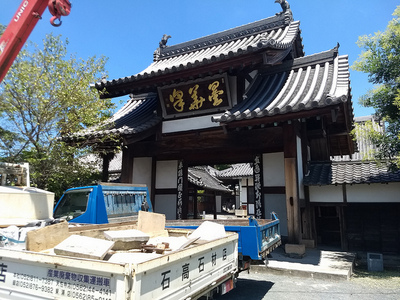Difference between revisions of "Zuisen-ji (Nagoya)"
| (2 intermediate revisions by the same user not shown) | |||
| Line 1: | Line 1: | ||
| + | [[File:Zuisenji.jpg|right|thumb|400px|The main gate at Zuisen-ji]] | ||
*''Other Names'': 竜蟠山 ''(Ryuuhanzan)'' | *''Other Names'': 竜蟠山 ''(Ryuuhanzan)'' | ||
*''Japanese'': 瑞泉寺 ''(Zuisen-ji)'' | *''Japanese'': 瑞泉寺 ''(Zuisen-ji)'' | ||
| − | Zuisen-ji is a [[Soto Zen|Sôtô Zen]] temple in [[Nagoya]]. | + | Zuisen-ji is a [[Soto Zen|Sôtô Zen]] temple in [[Nagoya]], in the neighborhood of the former [[Tokaido|Tôkaidô]] [[shukuba|post-station]] of [[Narumi-juku]]. It was originally established in [[1396]] by [[Yasuhara Munenori]]. The main gate of the temple, designated a cultural asset by [[Aichi prefecture]], dates back to [[1756]] and was designed in emulation of a gate at [[Manpuku-ji]] in [[Uji]].<ref>Plaques on-site.[https://www.flickr.com/photos/toranosuke/45389464245/sizes/l]</ref> |
| − | The grave of musician Tomiyama ''[[peechin]]'' aka [[Ryo Bunpitsu|Ryô Bunpitsu]] is located within the grounds. Bunpitsu ([[1794]]-[[1832]]) was a member of the 1832 [[Ryukyuan embassy to Edo]] who died on 11/3 that year, at [[Inaba-juku]] in [[Owari province]], and was buried at Zuisen-ji the following day. The temple also holds | + | The grave of musician Tomiyama ''[[peechin]]'' aka [[Ryo Bunpitsu|Ryô Bunpitsu]] is located within the grounds. Bunpitsu ([[1794]]-[[1832]]) was a member of the 1832 [[Ryukyuan embassy to Edo]] who died on 11/3 that year, at [[Inaba-juku]] in [[Owari province]], and was buried at Zuisen-ji the following day. The temple also holds several works of calligraphy by Bunpitsu, believed to have been brought to the temple by future Ryukyuan missions (in [[1842]] and [[1850]]) from Ryûkyû, as they visited their countryman's grave.<ref>''Minoji wo yuku Ryûkyû shisetsu'' 美濃路をゆく琉球使節, Bisai Museum of History and Folklore 尾西市歴史民俗資料館, Bisai, Aichi (2004), 12.</ref> |
| + | |||
| + | A grave for laborers hired by [[Satsuma han]] to accompany the Ryukyuan mission was once also located on the grounds. | ||
{{stub}} | {{stub}} | ||
| Line 10: | Line 13: | ||
==References== | ==References== | ||
*Watanabe Miki. "[http://www.geocities.jp/ryukyu_history/Japan_Ryukyu/Main.html Nihon ni okeru Ryûkyû shiseki]." (personal website) | *Watanabe Miki. "[http://www.geocities.jp/ryukyu_history/Japan_Ryukyu/Main.html Nihon ni okeru Ryûkyû shiseki]." (personal website) | ||
| + | <references/> | ||
==External Links== | ==External Links== | ||
| − | *[https://maps.google.com/maps?q=%E5%90%8D%E5%8F%A4%E5%B1%8B%E5%B8%82%E7%91%9E%E6%B3%89%E5%AF%BA&hl=en&ie=UTF8&sll= | + | *[https://maps.google.com/maps?q=%E5%90%8D%E5%8F%A4%E5%B1%8B%E5%B8%82%E7%91%9E%E6%B3%89%E5%AF%BA&hl=en&ie=UTF8&ll=35.078222,136.953965&spn=0.00117,0.002642&sll=34.68391,135.837811&sspn=0.004738,0.010568&t=h&z=19 Zuisen-ji on Google Maps] |
[[Category:Temples]] | [[Category:Temples]] | ||
[[Category:Ryukyu]] | [[Category:Ryukyu]] | ||
Latest revision as of 03:31, 18 December 2018
- Other Names: 竜蟠山 (Ryuuhanzan)
- Japanese: 瑞泉寺 (Zuisen-ji)
Zuisen-ji is a Sôtô Zen temple in Nagoya, in the neighborhood of the former Tôkaidô post-station of Narumi-juku. It was originally established in 1396 by Yasuhara Munenori. The main gate of the temple, designated a cultural asset by Aichi prefecture, dates back to 1756 and was designed in emulation of a gate at Manpuku-ji in Uji.[1]
The grave of musician Tomiyama peechin aka Ryô Bunpitsu is located within the grounds. Bunpitsu (1794-1832) was a member of the 1832 Ryukyuan embassy to Edo who died on 11/3 that year, at Inaba-juku in Owari province, and was buried at Zuisen-ji the following day. The temple also holds several works of calligraphy by Bunpitsu, believed to have been brought to the temple by future Ryukyuan missions (in 1842 and 1850) from Ryûkyû, as they visited their countryman's grave.[2]
A grave for laborers hired by Satsuma han to accompany the Ryukyuan mission was once also located on the grounds.
References
- Watanabe Miki. "Nihon ni okeru Ryûkyû shiseki." (personal website)
